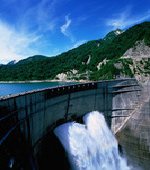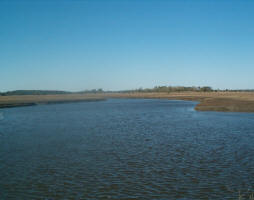 An Integrated Approach to the Efficient Management of Scarce Water Resources in West Africa
An Integrated Approach to the Efficient Management of Scarce Water Resources in West Africa
Problem Clusters
No single solution exists for complex decision related questions. To handle the complexity adequately, numerous problem clusters were defined. These are meta-problems which require a multi-disciplinary analysis in order to allow for drawing conclusions with respect to possible future developments. Nearly for every problem cluster a SDSS or IS is developed which provides tailored tools for decision making. In addition the effects of certain measures can be studied on the basis of different intervention scenarios.
Scenarios
Scenarios are consistent and plausible images of alternative futures that are rich enough to support the decision making process. A meaningful scenario shows different societal, ecological and technological aspects of the system under investigation. IMPETUS has developed scenarios in close cooperation with project partners from Benin and Morocco.
Spatial Decision Support Systems
Modern Spatial Decision Support Systems (SDSSs)
combine tools and analysis functionalities of DSS, GIS, remote sensing
(RS), and numerical models based on expert knowledge. Within IMPETUS a
platform independent SDSS-design and -development approach is
established by using ArcGIS Engine (ESRI®) and Java. With
the computer-based SDSSs, the user is able to visualize and analyze
(geo-)data and models based on a question-specific decision tree. more...
| Project number | n/a | ||
|---|---|---|---|
| Subject(s) | HYDRAULICS - HYDROLOGY , INFORMATION - COMPUTER SCIENCES , MEASUREMENTS AND INSTRUMENTATION , METHTODOLOGY - STATISTICS - DECISION AID , NATURAL MEDIUM , POLICY-WATER POLICY AND WATER MANAGEMENT , RISKS AND CLIMATOLOGY | ||
| Acronym | IMPETUS | ||
| Geographical coverage | Morocco, Benin | ||
| Budget (in €) | 0 | ||
| Programme | The global water cycle (GLOWA) | ||
| Web site | http://www.impetus.uni-koeln.de | ||
| Objectives | It is the goal of this research to develop management options for different components of the hydrological cycle, using the tools of Spatial Decision Support Systems (SDSS). The target years are 2025 for Benin and 2020 for Morocco. Decision making requires an exhaustive knowledge about processes, driving forces, stakeholders, and their possibilities. The objective consists in describing possible ways of future development, as well as their causes and their interactions. Whole sets of related central issues are treated in so called "problem clusters". These issues can be analysed and predicted only in a multidisciplinary approach. Adequate solutions for problem clusters must be found and also implemented. The identification of problem clusters, the development of scenarios and the elaboration of solution strategies requires a close co-operation between local institutions and organisations, i.e. local stakeholders, and scientists. This builds up the foundation allowing to develop strategies and computer aided decision support systems for the local decision makers in the course of the third phase (2006-2009).
--
GLOWA programme.
|
||
| Results | 1st Project Phase (2000-2003)Data Acquisition and ModellingDue to the importance of the hydrological cycle regarding the availability of fresh water, its different components and their interactions were identified in its complexity and quantified in the course of the first three-year phase of this project. In an integrated approach a sequence of existing models (both numerical and expert models) of the individual disciplines involved have been adapted and validated in order to describe the relationships and dependencies within the hydrological cycle in its present state. Local conditions and problems of each catchment also had to be taken into account. Basic research was only carried out if existing competence and experience proved to be insufficient. After the project had begun in 2000 it turned out that the pre-existing data bases were poor or incomplete for the needs of some of the disciplines involved. In these cases data acquisition campaigns and surveys were carried out especially in the field of socio-economy, anthropology and medicine. For the better adaptation and validation of the numerical models of the natural sciences the existing national monitoring networks were enforced. In the upper Ouémé catchment, the existing hydro-meteorological network was reinforced in cooperation with the IRD (Institut de Recherche pour le Développement) with focus on the Super Test Site "Aguima". In the Drâa catchment 12 climate stations and 10 fenced long-term observation plots of vegetation were installed along a height gradient ranging from the High Atlas to the pre-Saharan desert. Due to the approach in the 1st project phase IMPETUS shows a division into subprojects, according to the research regions in Project A (Ouémé catchment Benin) and Project B (Wadi-Drâa Morocco) and according to the research areas: The subprojects consider the atmospheric variability (A1/B1), the continental hydrosphere (A2/B2), and the important processes regarding the land use and land cover (A3/B3). Moreover, the influence of the socio-economical development (A4/B4) and of the cultural and medical situation (A5/B5) on the availability of drinking water is examined. By now division into the subprojects has merely an organisational and administrative importance. 2nd Project Phase (2003-2006)Development of Scenarios and Problem ClustersIn the second three-year phase the focus was set on future development. This was done on the basis of coupling suitable models. Since the integration of coupled models in a single system seems too complex disciplinary models were loosely coupled depending on the questions to be addressed. Due to the large uncertainty of models the future cannot be predicted precisely. Therefore the bandwidth of future developments has to be assessed with the help of likely scenarios. This also serves as a basis for assessment of suitable management options for decision makers. In a first step coarse scenarios were designed based on the general development in the countries under consideration and in agreement with local stakeholders. The design of scenarios took into account the following aspects: climate change, socio-cultural change, institutional change, population dynamics, economic development, and technological innovation. In a second step these coarse scenarios were regionalised and detailed for specific problems. To handle the complexity of these problems adequately, numerous so-called problem clusters were defined. 3rd Project Phase (2006-2009)Transfer and Application: Capacity Building and Spatial Decision Support SystemsThe scale-dependent assessment (in time and space) of future development constitutes the indispensable foundation for the design and implementation of management tools needed for decision makers in the course of the last three-year phase. One related task is the development of GIS based Spatial Decision Support Systems (SDSS) for the water resource management in the selected catchments of Benin and Morocco. A DSS is basically characterized as a computer based system which helps stakeholders to solve semi-structured processes by using data and analytical models. They incorporate user interfaces for the visualization, interpretation and evaluation of the selected data. With regard to spatial data, GIS functionalities need to be implemented which allow the users to generate spatially differentiated decisions. Due to the research activities, IMPETUS cooperates with decision-makers on very different levels in terms of education and knowledge. Users with limited knowledge are guided through standard processes and simple to use functionalities with preset parameters. For experts, the user interfaces allow to set decision relevant input parameters in order to show the effects. For the output of results, tools are implemented which generate specific presentations in terms of maps and reports. Capacity building is a further area of activities that will be intensified in the third phase. The implementation of SDDS, beside other important themes, must be accompanied by training courses to assure their usability together with the databases and the management options developed in IMPETUS. The level on which capacity building activities are realized is defined in the context of the problem clusters and the general framework in Benin and Morocco. For example, in Benin important activities focus on the communes, which obtained considerable competences, especially for water and land use management, due to the decentralization process. They now have to improve their abilities in order to exercise these competences. Nevertheless, of the same significance are capacity building activities offered to other partners like water authorities or other technical services on the national and regional level, universities and research centers, development agencies and representatives of the civil society. Detailed presentations and results of the project phases are available in the sections Publications and Reports. -- Data The metadatabase contains the information about the datasets available within the IMPETUS project. The metadatabase contents are filtered by using the search form (Search / Public). Furthermore, from the specific metadata sheet, data requests can be directed to the contact person (Request Button) by e-mail. The contact person then verifies if the dataset is enabled to be transferred to external users according to the IMPETUS rules for data exchange and data use constraints (French, German). |
||
| Period | [01/01/2000 - 31/12/2009] | ||
 you are not logged in
you are not logged in





